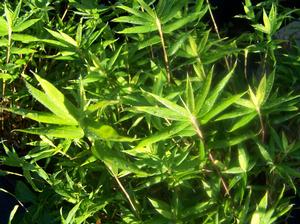
1. Pleioblastus pygmaeus 'Wooster's Dwarf' - this very low-growing, spreading bamboo will make a tough, low maintenance ground cover set in part to full sun planted in fertile soil.
Lawns Part V: Lawn Alternatives - Groundcovers for Sun
Lawns require much time and maintenance: fertilizing, weeding, mowing, liming and raking. Perhaps you neither want nor require an expansive sea of grass now that the kids are grown. Maybe your life is over-scheduled. Or perchance you want to put your feet up with greater frequency and read a great novel. In areas where lawn is no longer desired groundcovers will cut maintenance and save you time. A little effort now can reap huge savings in energy costs and time savings in the repetitive hours it takes to care for your present lawn on its weekly schedule.
Groundcovers that serve to squelch weeds in a broad sense can be mat-forming perennials, large suckering shrubs, small trees and everything in between. Of course, in sun or shade one may employ Japanese Pachysandra – overused to the point of cliché, and there are “Bugleweed” (Ajuga) cultivars which will certainly form a weed-proof mat. But let’s examine some other less usual candidates.
There is a bamboo that only grows 2 to 6 inches tall. Pleioblastus (syn. Arundinaria) pygmaeus ‘Wooster’s Dwarf’ (see pic 1) will form a lovely clean green groundcover in draining humus-laden soils in sun to part shade. If you wish to keep Pleioblastus within defined bounds you can place barriers in the soil that will contain it. This plant once established will require virtually no work and only the occasional weed will have to be uprooted.
BOTTLEBRUSH BUCKEYE IS A KNOCKOUT IN BLOOM
Bottlebrush Buckeye (Aesculus parviflora) will form a slow growing large shrub with serrated five-fingered leaves. Huge inflorescences of white flowers in summer resembling giant bottlebrushes rise on erect spikes in early summer. This magnificent plant will eventually grow about 6 feet tall by 12 feet wide. One or more would be beautiful as a step down from a group of specimen trees. The foliage may possibly display a nice yellow in the autumn before the leaves fall. There had been a very old and beautiful specimen on the Episcopal Church property on the knoll at the intersection of routes 6 and 169 in Brooklyn Center before it was cut down. It was a knockout in bloom!
Our native “Bearberry” (Arctostaphylos uva-ursi) loves full sun and acid conditions in sand and gravel scrabble where lawns would have difficulty taking hold. Mixing some peat moss in with a bony blend will make a hospitable foundation for this blueberry relative. “Kinickinick”, as it is also commonly called, will grow about 6 inches tall and up to 4 feet wide. Glossy green leaves like small tongues turn reddish bronze in fall and winter. Red berries follow the small pinkish white bell flowers.
“Cranberry” (Vaccinium macrocarpum - see pic 2), another ericaceous blueberry relative, will also make a really beautiful groundcover. Contrary to popular misconception Cranberry does not require constantly flooded conditions. In fact, it is completely content in acid, moisture retaining humus soils in full sun. As with “Bearberry” add plenty of peat to a soil mix. Tiny elliptical leaves up and down the tangle of wiry stems are a good green through the growing season turning a rich wine in the autumn and lasting for much of the winter. Small pinkish bell flowers will develop into large fruit which can be picked or left to wildlife. Wild turkeys love cranberry just as we love both at Thanksgiving!
Under dry sun in quickly draining soils where nearly constant watering is the only way to keep the grass green why not a grouping of Yuccas? There are some beautifully colored variants of Yucca filamentosa such as ‘Color Guard’ and ‘Golden Sword’. Add the fine-bladed gray, silver-edged Yucca glauca, almost never seen and perfectly hardy in our region (see pic 3). Throw in some Winter Savory (see pic 4) for softer textural contrast; it is virtually evergreen turning burgundy in cold weather. Mix in some Hens and Chicks (Sempervivum) and Sedum for a truly raucous display.
There is a growing movement whereby some homeowners are planting vegetable gardens sometimes mixed with ornamentals in their front yards, a very European practice. This clearly would be a more labor-intensive endeavor but the rewards are organically grown fresh vegetables direct from your garden to your dinner table.
A myriad of possibilities exists. You can alter that expansive lawn to which you have become enslaved. You can reduce the money and lessen the time it takes to maintain that overly large tract of yard. You can be an environmental superhero who protects children, pets and wildlife. You can free yourself. You can make your life easier in the long run with a little action now. But before you erect a hammock and take it a little easier stay tuned for the final installment of the lawn and groundcover series. We will break entirely with the concept of lawn and look at the wildflower meadow as an alternative. Stay tuned.
Penned by Wayne Paquette, Winter 2007

